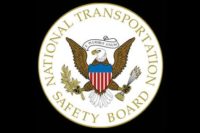The National Transportation Safety Board (NTSB) has launched a 15-member Go Team to investigate today’s derailment of a Union Pacific freight train near Graettinger, Iowa.
Initial reports received by the NTSB’s Response Operations Center indicate there were no injuries or fatalities associated with the derailment of 27 rail tank cars near Jack Creek in Iowa. Those reports further indicated the train included three locomotives and 101 cars, 100 of which were reported to be carrying ethanol. Initial reports further indicated some of the cars were on fire and that an unknown amount of the ethanol had spilled into the creek.
Part of the NTSB’s Go Team is launching from Biloxi, Mississippi, where board member Robert Sumwalt and NTSB support staff were demobilizing from the launch for Tuesday’s bus and train collision there. Other members of the Go Team deployed from NTSB headquarters in Washington.
Initial reports indicate the rail tank cars involved in this accident are legacy DOT-111 rail tank cars. The NTSB has identified many vulnerabilities in the DOT-111 tank car design that create the risk of the release of hazardous materials or flammable liquids when those tank cars are involved in an accident. In light of those demonstrated vulnerabilities Congress mandated the rail industry to, by 2029, end the use of DOT-111 rail tank cars for the transport of hazardous materials or flammable liquids and use tank rail cars built to the more robust DOT-117 standard, designed to reduce the vulnerabilities found in DOT-111 tank cars.
According to Association of American Railroads statistics for August 2016, there are a total of about 99,000 DOT-111 and CPC-1232 tank cars that require retrofitting or replacement by 2029, or an average of about 7,700 tank cars per year. As of August 2016, about 1,400 existing tank cars have been retrofitted to the DOT-117 standard. About 10,839 new DOT-117 cars have been built, but fewer than half have been deployed in flammable liquids service.
The NTSB’s position on implementing the use of DOT-117 rail tank cars has been consistent – vulnerable DOT-111 tank cars must be replaced as quickly as possible with the new DOT-117 design. The deadline for replacing less-robust tank cars extends more than 12 years, from 2018 to 2025 for crude and ethanol, and to 2029 for all other Class 3 flammable materials.





